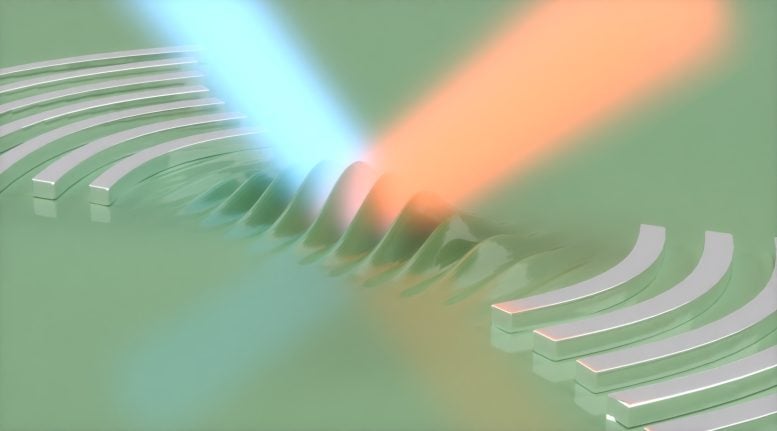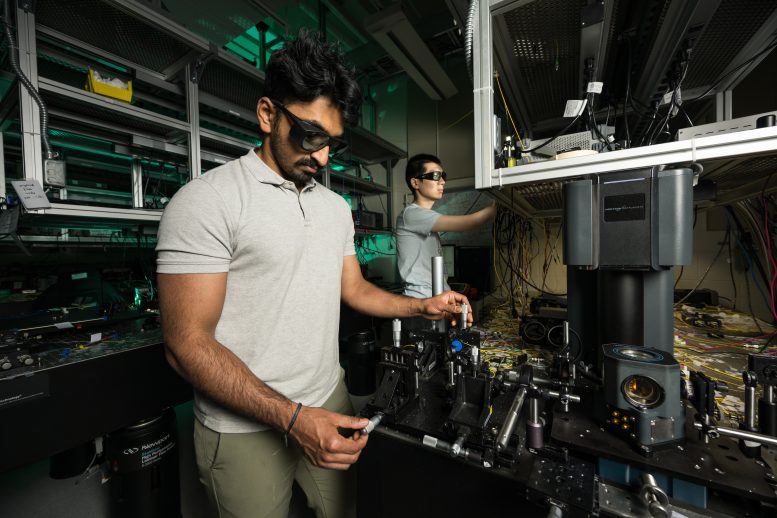
Researchers have developed new methods for coupling light to surface-gliding sound waves.
Researchers at the University of Rochester have employed surface acoustic waves to tackle a major challenge in the development of a quantum internet.
In a new study published in <span class="glossaryLink" aria-describedby="tt" data-cmtooltip="
” data-gt-translate-attributes=”[{"attribute":"data-cmtooltip", "format":"html"}]” tabindex=”0″ role=”link”>Nature Communications, scientists from Rochester’s Institute of Optics and Department of Physics and Astronomy describe a technique for pairing particles of light and sound that could be used to faithfully convert information stored in quantum systems—qubits—to optical fields, which can be transmitted over long distances.
What are surface acoustic waves?
Surface acoustic waves are vibrations that glide along the exterior of materials like a wave in the ocean or tremors along the ground during an earthquake. They are used for a variety of applications—many of the electrical components of our phones have surface acoustic wave filters—because they make very precise cavities that can be used for precise timing in uses like navigation. But scientists have begun using them in quantum applications as well.

“In the last 10 years, surface acoustic waves have emerged as a good resource for quantum applications because the phonon, or individual particle of sound, couples very well to different systems,” says William Renninger, associate professor of optics and physics.
Using existing methods, surface acoustic waves are accessed, manipulated, and controlled through piezoelectric materials to turn electricity into acoustic waves and vice versa. However, these electric signals must be applied to mechanical fingers inserted into the middle of the acoustic cavity, which causes parasitic effects by scattering phonons in ways that have to be compensated for.
Using light to manipulate surface acoustic waves
Rather than coupling the phonons to electric fields, Renninger’s lab tried a less invasive approach, shining light on the cavities and eliminating the need for mechanical contact.
“We were able to strongly couple surface acoustic waves with light,” says Arjun Iyer, an optics PhD student and first author of the paper. “We designed acoustic cavities, or tiny echo chambers, for these waves where sound could last for a long time, allowing for stronger interactions. Notably, our technique works on any material, not just the piezoelectric materials that can be electrically controlled.”
Renninger’s team partnered with the lab of Associate Professor of Physics John Nichol to make the surface acoustic wave devices described in the study. In addition to producing strong quantum coupling, the devices have the added benefits of simple fabrication, small size, and the ability to handle large amounts of power.
Beyond applications in hybrid <span class="glossaryLink" aria-describedby="tt" data-cmtooltip="
” data-gt-translate-attributes=”[{"attribute":"data-cmtooltip", "format":"html"}]” tabindex=”0″ role=”link”>quantum computing, the team says their techniques can be used for spectroscopy to explore the property of materials, as sensors, and to study condensed matter physics.
Reference: “Coherent optical coupling to surface acoustic wave devices” by Arjun Iyer, Yadav P. Kandel, Wendao Xu, John M. Nichol and William H. Renninger, 11 May 2024, Nature Communications.
DOI: 10.1038/s41467-024-48167-7
The research was supported through the National Science Foundation, the Defense Advanced Research Projects Agency, and the Office of Naval Research.
